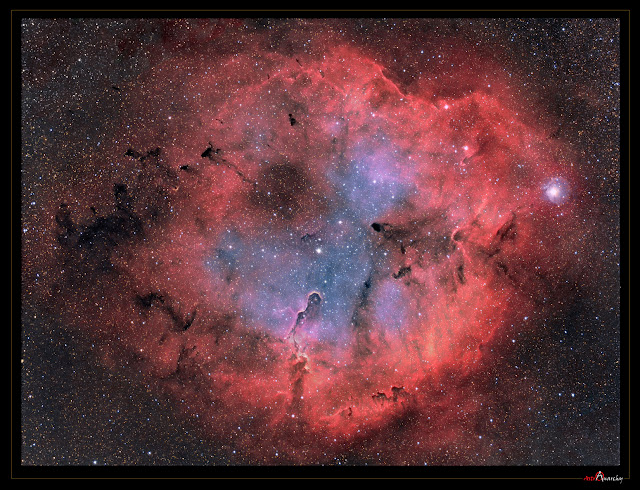COPYRIGHT, PLEASE NOTE
All the material on this website is copyrighted to J-P Metsavainio, if not otherwise stated. Any content on this website may not be reproduced without the author’s permission.
Have a visit in my portfolio
PORTFOLIO:https://astroanarchy.zenfolio.com/
Wednesday, October 19, 2011
Dark dust in Cygnus as a stereo pair 3D
Other 3D-formats:
Original 2D:
Labels:
stereo images
Dark dust in Cygnus as an anaglyph Red/Cyan 3D
3D-NOTE!
You'll need Red/Cyan Eyeglasses to be able to see images as 3D.
If you have a Red and Blue filters, you can use them! Red goes to Left eye.
You'll need Red/Cyan Eyeglasses to be able to see images as 3D.
If you have a Red and Blue filters, you can use them! Red goes to Left eye.
Other 3D-formats:
Original 2D:
Labels:
anaglyph images and movies
Monday, October 17, 2011
IC 1396, the home of the "Elephant's trunk Nebula"
IC 1396
In constellation Cepheus
HST-palette, from the emission of ionized elements,
R=Sulfur, G=Hydrogen and B=Oxygen.
At the same night, 16. October, I shot my previous target, I had some time left before dawn.
I shot few frames, 6x1200s, of H-alpha for IC 1396. Last time I shot this target, I was using a HY8 single shot color astronomical camera. As it's a color camera, bayer matrix cuts down the effective resolution about 1/4 of the native resolution of CCD. I wanted to test, how visible this difference is.
Older image of IC 1396 can be seen HERE. The difference in resolution is impressive, stars are much tighter now. i did use O-III and S-II channels from this older image to build color compositions. (Resolution of those channels doesn't have any effect to my final image, since I'm using my "Tone Mapping" technique.
IC 1396 spans hundreds of light years at distance of about 3000 light years in constellation Cepheus. The famous formation of glowing gases, the "Elephant's Trunk Nebula" can be seen at six a clock position.
This is an active star formation region and it has several massive young stars inside of it, coursing the ionization of elements in this emission nebula.
I have made a study about the apparent size in a sky:
R=Hydrogen + Sulfur, G=Oxygen and B=Oxygen + Hydrogen.
Older, longer focal length, closeup image of the "Elephant's trunk Nebula"
http://astroanarchy.blogspot.com/2011/01/elephants-trunk-nebula-inside-ic-1396.html
A 100% crop from the image to show the resolution.
Technical details:
Processing work flow:
Image acquisition, MaxiDL v5.07.
Stacked and calibrated in CCDStack2.
Levels, curves and color combine in PS CS3.
Optics, Tokina AT-X 300mm camera lens at f2.8
Camera, QHY9 , a cooled astronomical camera
Guiding, Meade LX200 GPS and the Lodestar guider
Image Scale, ~3,5 arcseconds/pixel
Exposures H-alpha 6x1200s, binned 1x1
(S-II and O-III are borrowed from an older image)
O-III 8x1200s, binned 2x2, QHY8
S-II 3x1200s, binned 2x2, QHY8
Sunday, October 16, 2011
Dark dust in Cygnus, project finalized
This beautiful area is just bellow the North America and Pelican Nebulae. The bright area at upper middle Right, is known as IC 5068.
I selected this as a target, since there is a beautiful dark dust line blocking light at front of the ionization zone and the area is not too commonly imaged. You can see the image in just Ha-light and an image about the relative location in my previous blog post.
Area of interest, just bellow NGC7000, can be seen in this image as a gray scale rectangle.
R=Sulfur, G=Hydrogen and B=Oxygen.
A 100% crop from the image to show the resolution.
An experimental starless image to show the nebula better.
Technical problems are still driving me nuts... I had to operate nearly everything manually, since my TCF-s focuser and the filter wheel are out of order. Focusing at f2.8 is not an easy task, the critical focus zone is just about 15/1000mm. I had to refocus between the frames, since temperature dropped during the night and I didn't have my temp. compensating focuser operational.
Technical details:
Processing work flow:
Image acquisition, MaxiDL v5.07.
Stacked and calibrated in CCDStack2.
Deconvolution with a CCDStack2 Positive Constraint, 33 iterations,
added in about 50% weight.
Levels, curves and color combine in PS CS3.
Optics, Tokina AT-X 300mm camera lens at f2.8
Camera, QHY9 , a cooled astronomical camera
Guiding, Meade LX200 GPS and the Lodestar guider
Image Scale, ~3,5 arcseconds/pixel
Exposures H-alpha 19x1200s, binned 1x1
O-III 8x1200s, binned 2x2
S-II 6x1200s, binned 2x2
Total exposure time ~12h
Subscribe to:
Posts (Atom)



















